Infographic: Severing Iran’s Path to a Nuclear Weapon
JINSA is issuing a new interactive infographic explaining the impacts of U.S.-Israeli strikes against Iran’s nuclear weapons program, and illustrating Iran’s potential covert pathways to a bomb that may have survived the recent conflict.
Scroll below for a slideshow version of the infographic, with detailed information on the status of each key element of Iran’s nuclear weapons program.
Graphic 1: Isfahan Conversion Plant
Satellite imagery shows U.S.-Israeli strikes “severely damaged” this facility, likely “knocking it out of operation.”
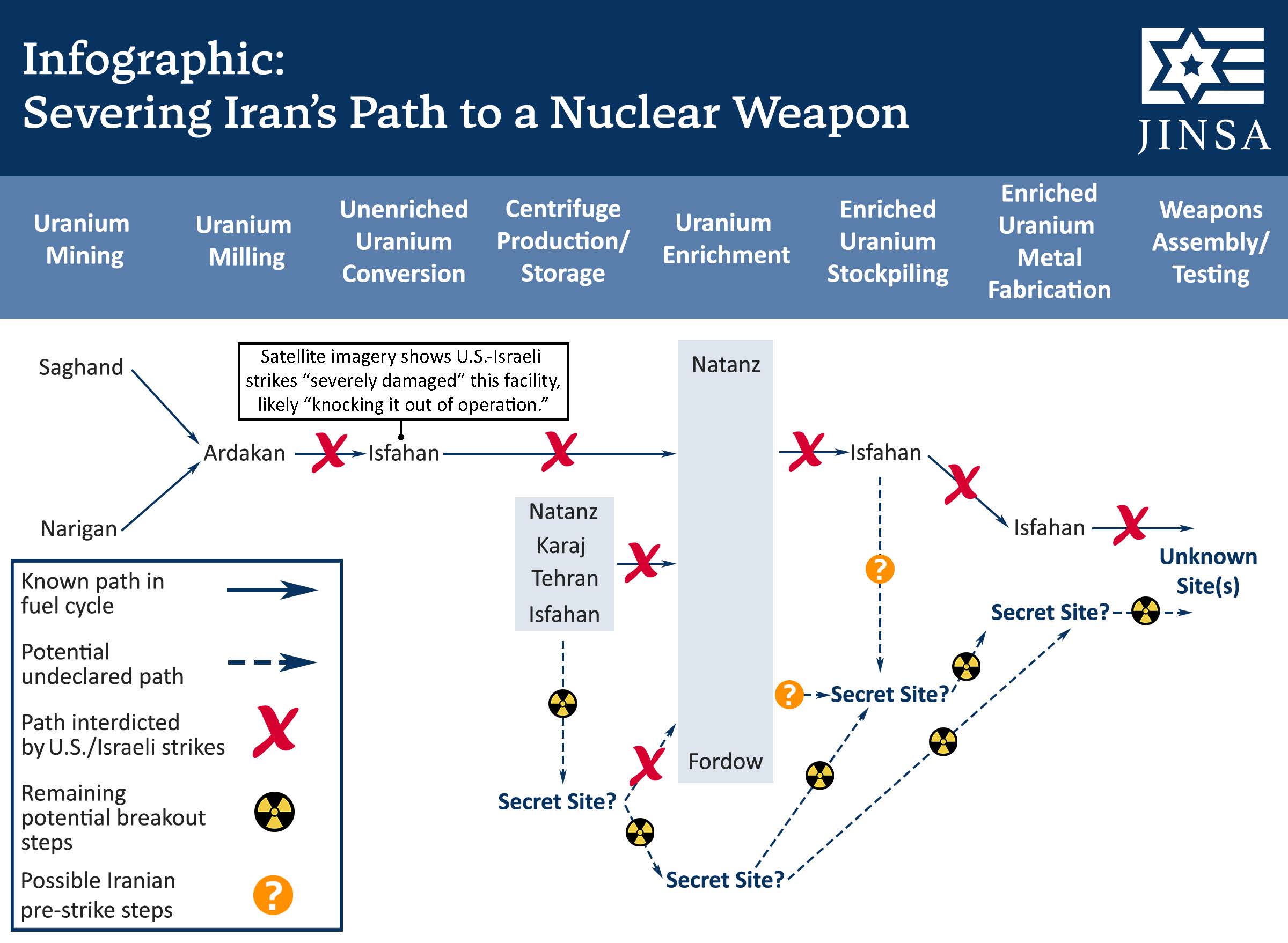
Graphic 2: Centrifuge Production and Storage Sites
Israeli airstrikes damaged or neutralized facilities at Isfahan, Karaj, and Tehran, but it is unlikely the underground centrifuge manufacturing site near Natanz was seriously damaged.
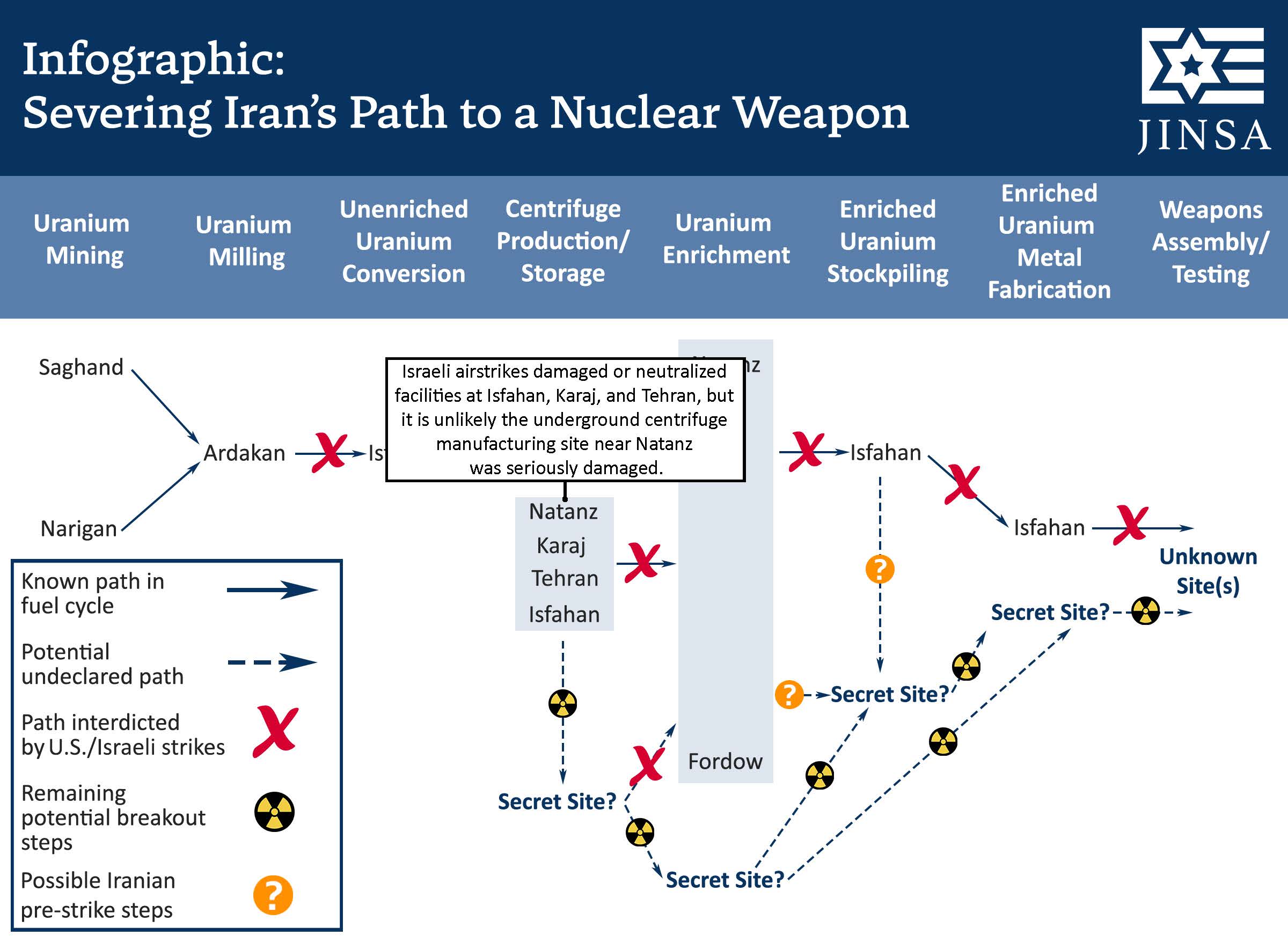
Graphic 3: Potential Undeclared Centrifuge Sites
Inspectors and analysts have warned of suspected undeclared sites before and after U.S.-Israeli strikes:
IAEA 5/31: “The Agency has lost continuity of knowledge in relation to [Iran’s] production and inventory of centrifuges….”
IAEA 6/16: Iran has unknown numbers of centrifuge workshops.
David Albright 6/22: Iran may have thousands of centrifuges that were never installed in Natanz and Fordo.
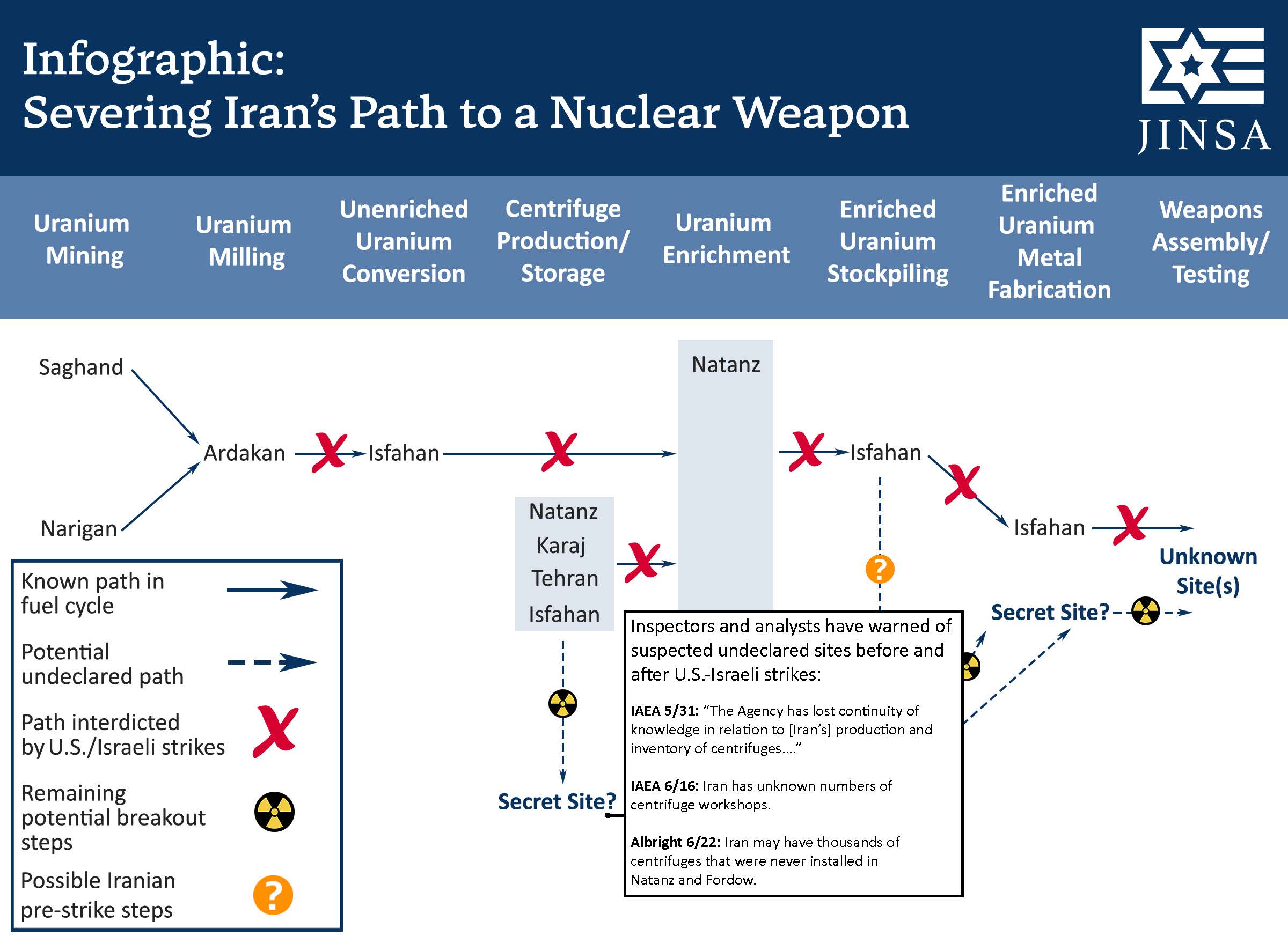
Graphic 4: Natanz Enrichment Facility
U.S.-Israeli strikes are assessed to have damaged or destroyed the Natanz complex:
IAEA 6/22: U.S.-Israeli “completely destroyed” the aboveground enrichment R&D plant and “significantly damaged” the main underground enrichment halls.
Good ISIS 6/24: U.S. strikes likely knocked enrichment halls out of operation.
CIA Director Ratcliffe 6/25: “Several key Iranian nuclear facilities were destroyed and would have to be rebuilt over the course of years.”

Graphic 5: Undeclared Enrichment Sites
The possibility remains that undeclared enrichment sites were not hit or damaged:
IAEA 6/19: Iran announces a new enrichment plant near Isfahan, but the IAEA has not yet visited the site.
Good ISIS 6/24: Satellite imagery shows “no damage” to the deeply-buried Mt. Kolang Gaz La (“Pickaxe”) site, which the IAEA previously warned is home to “numerous and important activities” for Iran’s nuclear program.

Graphic 6: Isfahan Uranium Stockpile
There are conflicting reports on the status of Isfahan’s underground uranium stockpile facility:
Secretary of State Rubio 6/22: “No one will know for sure for days…. We have to assume that that’s a lot of 60% enriched uranium buried deep under the ground there in Isfahan.”
IAEA 6/22: U.S. strikes hit the entrances to the tunnels at the Isfahan site.
Jeffrey Lewis 6/22: “There does not seem to have been any effort to destroy these tunnels or the material that was in them.”
Vice President Vance 6/23: “Our main goal was to bury the uranium and I do think the uranium was buried.”
Good ISIS 6/24: “No damage” is visible to Isfahan underground tunnel complex.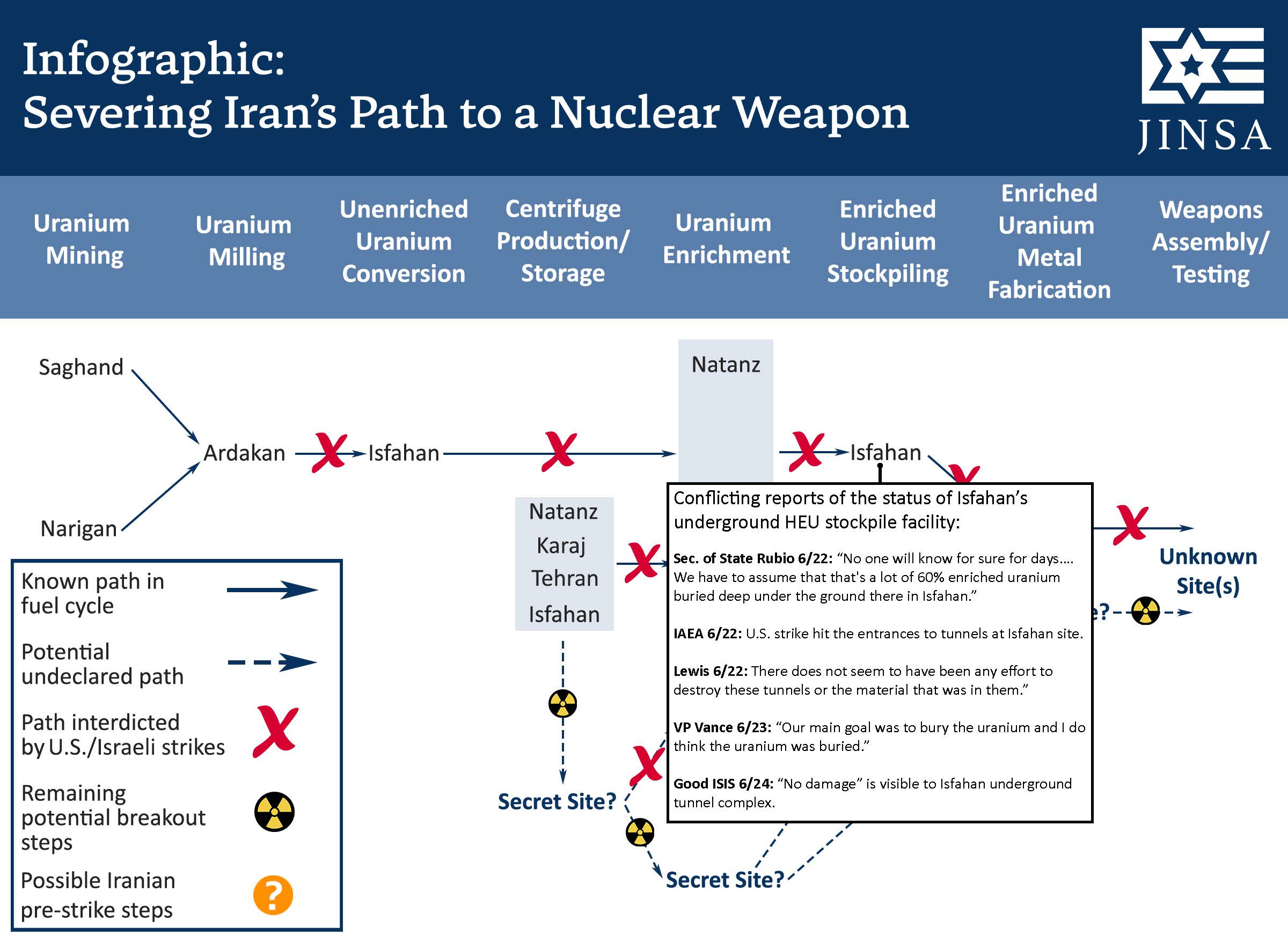
Graphic 7: Iranian attempt to move nuclear material from Fordow
There are conflicting reports on Iran removing highly enriched uranium from Fordow before U.S. strikes:
NY Times 6/22: Initial Israeli assessment that satellite images “show Iranian moving uranium and equipment from the Fordo facility.”
Defense Intelligence Agency 6/24: Much of Iran’s stockpile was moved before the strikes, which destroyed little of the nuclear material. Some of that may have been moved to secret nuclear sites.
Graphic 8: Isfahan Conversion Plant
The uranium metal conversion plant at Isfahan is generally assessed to have been destroyed:
Good ISIS 6/24: Satellite imagery shows the plant at Isfahan “was destroyed.”
Axios 6/25: Israeli officials assess that the site was destroyed.
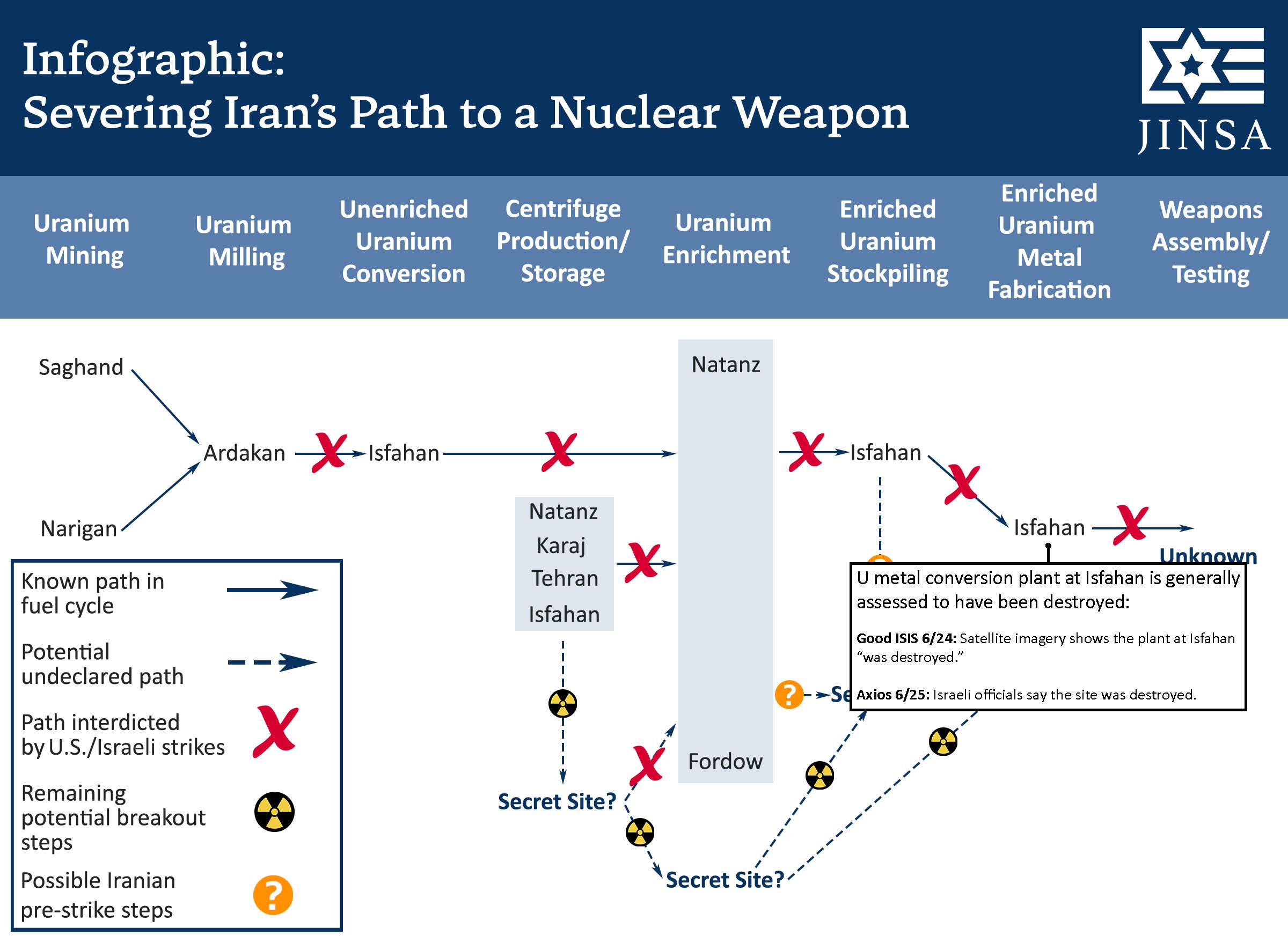
Graphic 9: Potential Undeclared Uranium Metal Fabrication Site
Inspectors and analysts have extensively documented Iran’s prior undeclared uranium metal work:
IAEA 5/31: Iran violated its Nuclear Non-Proliferation Treaty safeguards by using and processing uranium metal for the production of a nuclear explosive device at undeclared site(s).
David Albright 6/23: “We don’t know for sure what happened to the equipment that was in” Iran’s previous pilot plant for uranium metallurgy.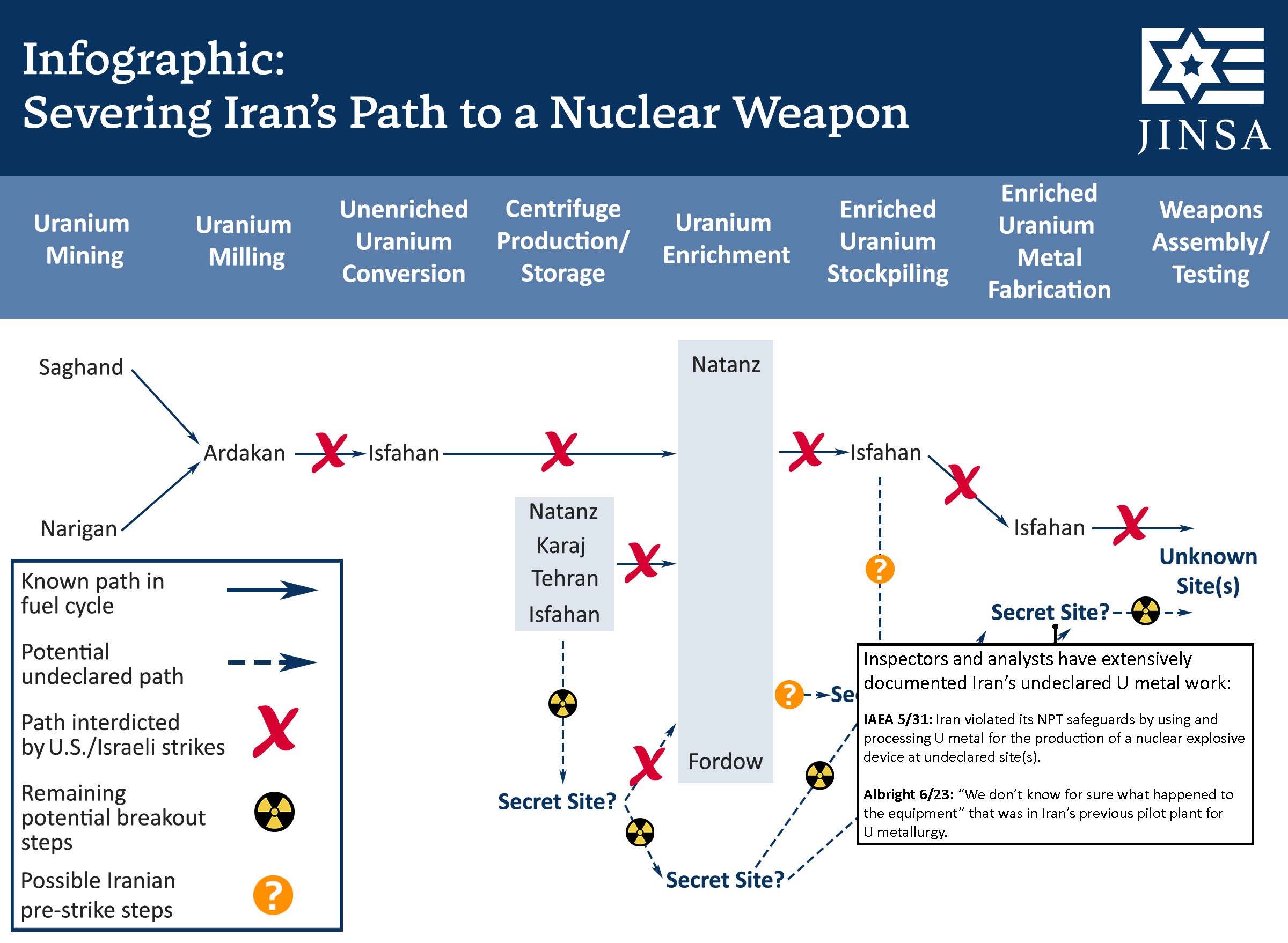
Graphic 10: Fordow Enrichment Site
U.S. strikes likely damaged Fordow significantly, though full assessments are pending:
IAEA 6/23: The site’s advanced centrifuges “were probably significantly damaged” but a full picture isn’t possible until inspectors can return to the facility.
Good ISIS 6/24: U.S. strikes “likely severely damaged or destroyed” the site.
CIA Director Ratcliffe 6/25: “Several key Iranian nuclear facilities were destroyed and would have to be rebuilt over the course of years.”
IAEA 6/26: Given the power of the U.S. strikes, “we already know that these centrifuges [at Fordow] are no longer operational…. There was no escaping significant physical damage.”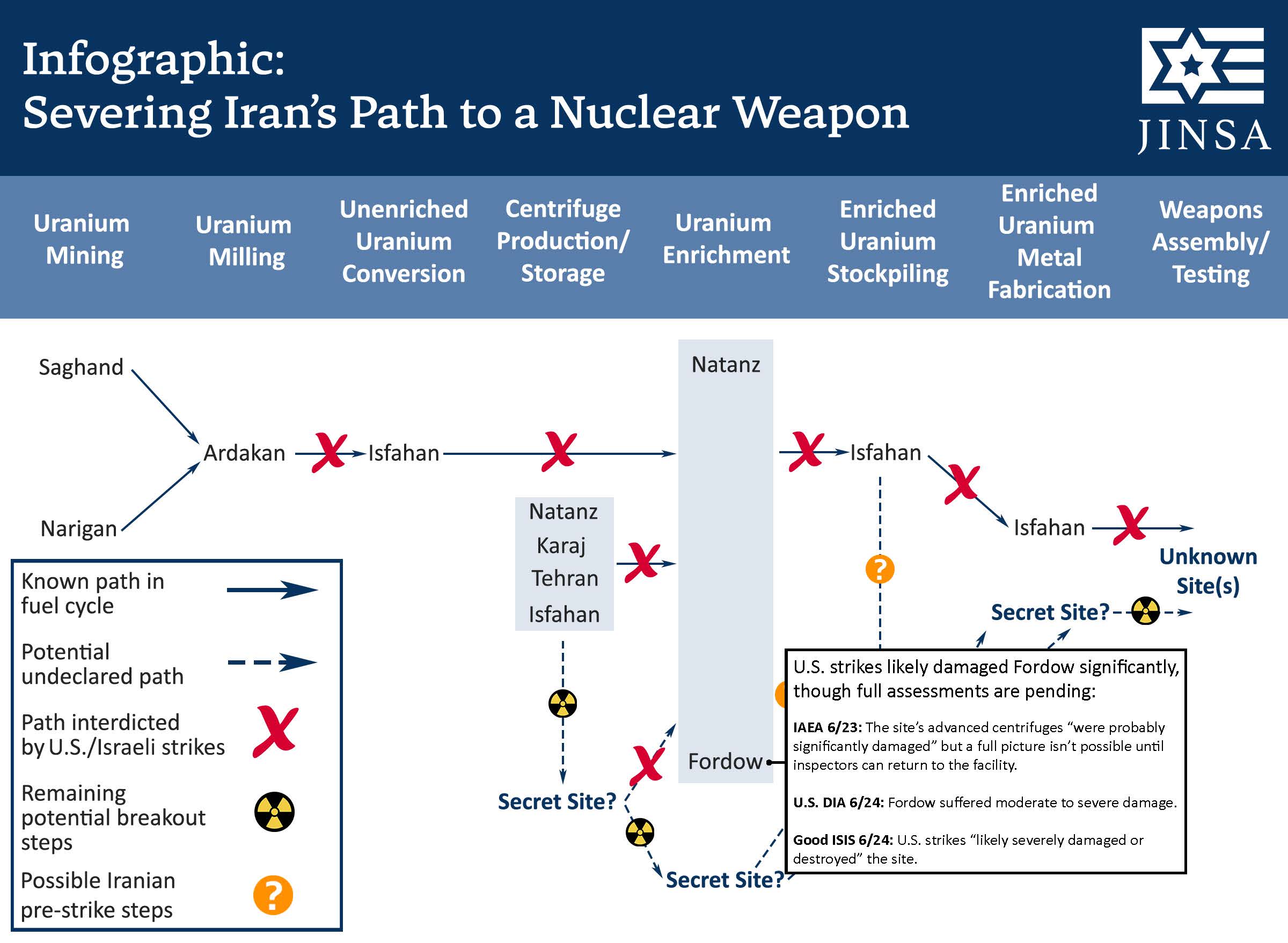
Graphic 11: Iranian Steps to Remove Uranium from its Isfahan Stockpile
Various reports that Iran removed uranium stockpiles from Isfahan before U.S.-Israeli strikes:
Iran Foreign Minister Araghchi 6/13: Iran is implementing “special measures to protect nuclear equipment and material.”
IAEA 6/22: “Iran has made no secret that they have protected” their “stockpile of 400 kg of 60% highly enriched uranium.” The IAEA last verified the stockpile on June 10.
NY Times 6/22: There is “growing evidence” Iran removed 400 kg of 60% highly enriched uranium from Isfahan prior to U.S. strikes.
Vice President Vance 6/22: “We’re going to work in the coming weeks to ensure that we do something with that fuel [400 kg of 60% highly enriched uranium].”
Defense Intelligence Agency 6/24: Iran reportedly retains control of almost all of its nuclear material.
IAEA 6/24: “We do not have information of the whereabouts of this material.”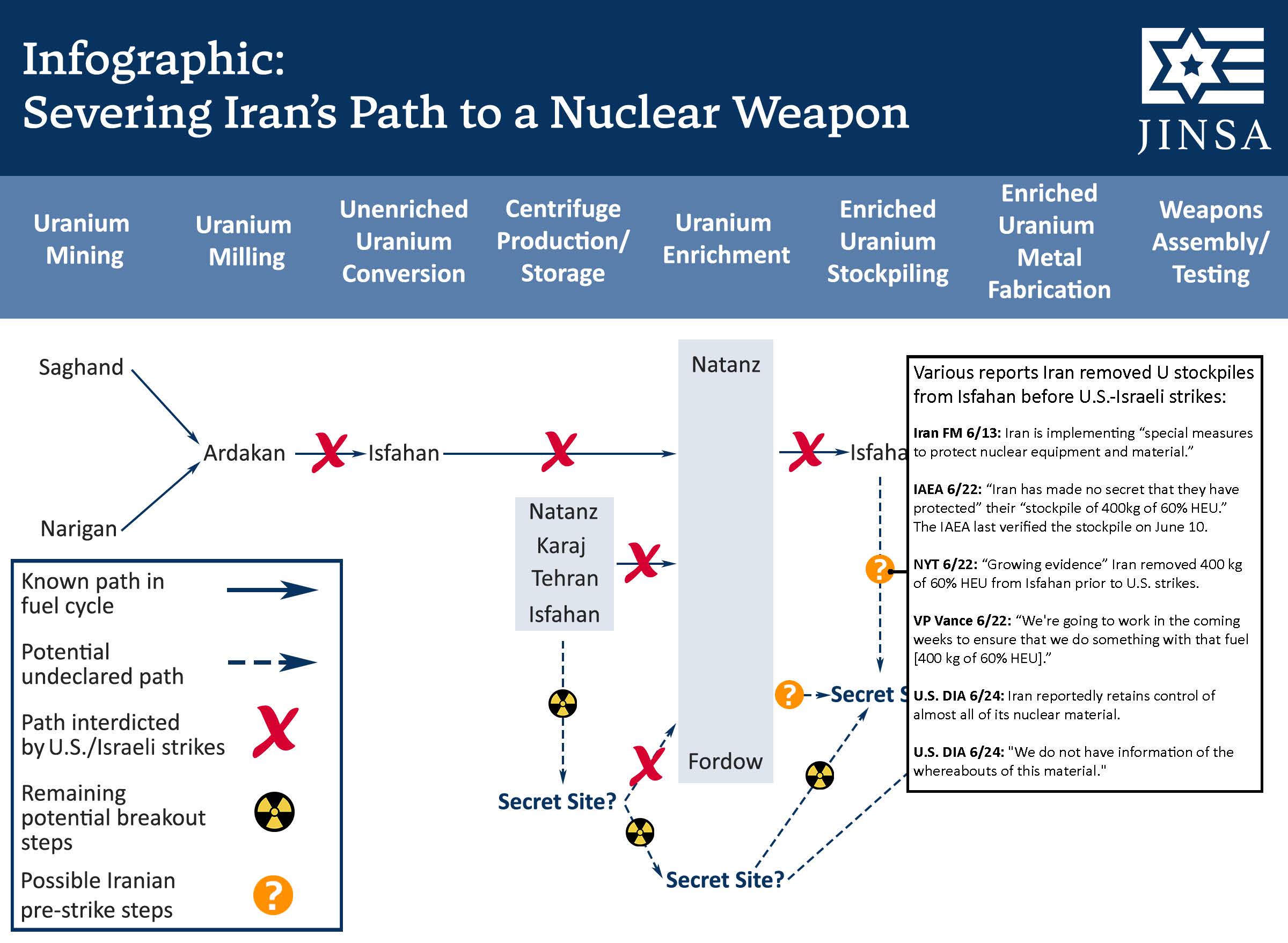
Graphic 12: Undeclared Weaponization Sites
Israeli strikes “extensively damaged” several undeclared weapons testing and manufacturing sites and killed relevant scientists, though other secret sites and relevant personnel likely remain.
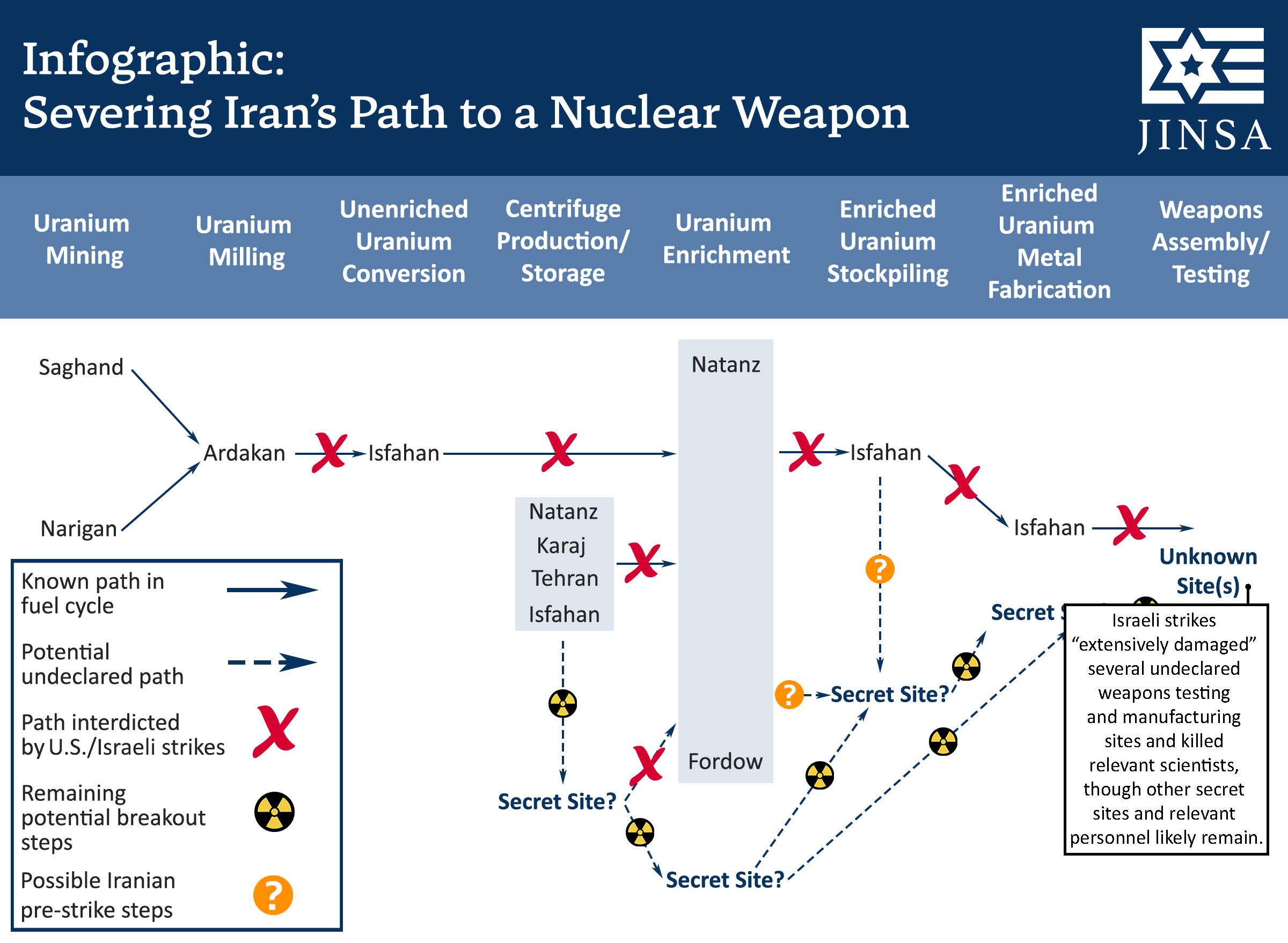
Graphic 13: Potential Undeclared Uranium Stockpiles
Inspectors and analysts have warned repeatedly of suspected undeclared Iranian uranium stocks:
David Albright 6/22: “You have to assume that significant amounts of this enriched uranium still exist, so this is not over by any means.”
CNN 6/24: “U.S. officials believe Iran maintains secret nuclear facilities that were not targeted in [U.S.] strikes and remain operational.”
Good ISIS 6/24: Satellite imagery shows “no damage” to the deeply-buried Mt. Kolang Gaz La (“Pickaxe”) site, where the IAEA “could not exclude” the possibility of Iran storing undeclared material.
